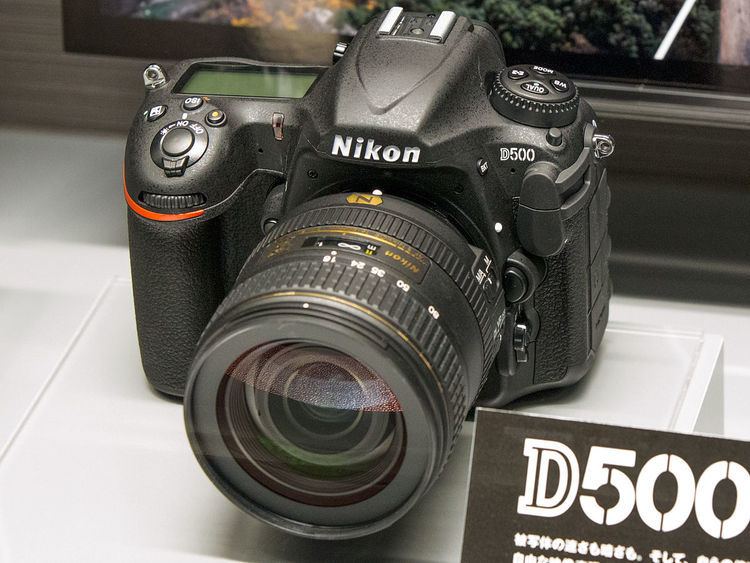The Nikon D500 is a 20.9-megapixel professional digital single-lens reflex camera using an APS-C sensor. It was announced by Nikon Corporation on 6 January 2016 along with the Nikon D5 FX format camera. It replaced the D300S as Nikon's DX format flagship DSLR. On 23 February 2017, at CP+ show, a special edition was released for Nikon's 100th anniversary.
Nikon DX format 20.9 megapixel CMOS sensor4K UHD video in 30p, 25p, and 24p1.5x field of view cropLarge, bright viewfinder with 100% frame coverage and 1x magnificationNikon EXPEED5 image processorMagnesium alloy and carbon fiber weather-sealed bodyNikon F-mount lensesActive D-Lighting (three levels)180K pixel RGB metering system.Retouch menu includes filter type, hue, crop, D-lighting, Mono (Black and White, Cyanotype or Sepia)Multi-CAM 20K autofocus module with 153 sensors in normal mode with 99 cross-type sensors. Of these points, 15 will work with any lens/teleconverter combination with a maximum aperture of f/8 or larger.Of the 153 points, 55 are user-selectable; 35 of those points are cross-type, and 9 will work down to f/8.Focus points' low-light performance: -4EV (central focus point) and -3EV (other 152 focus points)Auto AF fine-tune achieves focus tuning in live view through automatic setting of adjustment value with a few button operations.Live View ModeBuilt-in sensor cleaning (using ultrasound) helps to remove the dust from sensor10 frame-per-second continuous shooting for up to 200 RAW images (14-bit lossless compressed RAW) and 79 RAW images (14-bit uncompressed RAW)3.2 inch 2,359,000 dots tilting LCD touchscreen10-pin remote and flash sync terminals on cameraISO 100–51,200, selectable in 1/3-, 1/2- or 1-stop increments. Additionally, ISO 50 to ISO 1,640,000 are available with ISO Boost.Selectable in-camera ISO noise reduction, applied in post-processing.No Built-in flash.File formats include JPEG, TIFF, NEF (Nikon's raw image format compressed and uncompressed), and JPEG+NEF (JPEG size/quality selectable)Dual memory card slots (one SD and one XQD)The D500 can be set to automatically delay its shutter release to compensate for flickering electric lighting. It is the first Nikon camera to include this feature, which was initially absent from the professional D5 announced on the same date. This feature was added to the D5 via a June 2016 firmware update.The Nikon D500 uses the popular Nikon EN-EL15 battery and is shipped with the current Li-ion20 version. If used with the previous generation Li-ion01 version, the D500 may report a low amount of charge remaining, and take fewer shots than expected from a fully charged battery. On May 27, 2016, Nikon announced they will replace older EN-EL15 Li-ion01 batteries for D500 owners.

